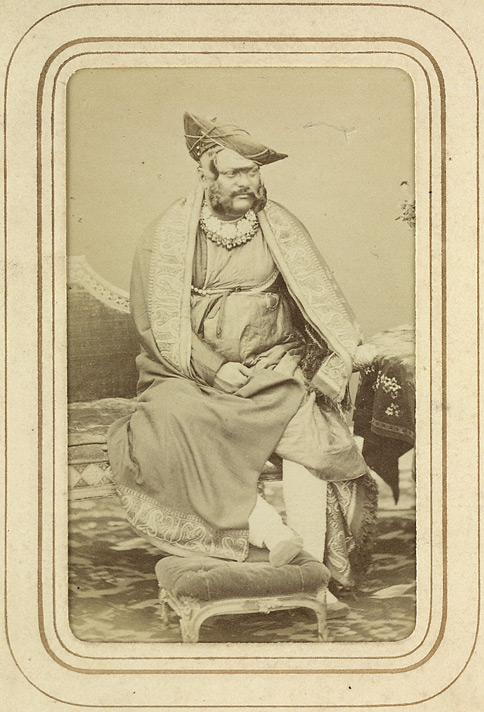Legendary Treasures of Princely India - Gwalior : Evidence
Written by : Amita Roy
Dated: January 22,2019
Share

Maharaja of Gwalior, Jayajirao Scindia (1835-1886)

The cover page of the file from National Archives of India. The 10 page report is set up as per page sequence.
Intrigue, curiosity, suspense, mystery is something always associated with treasures. The erstwhile princely states from India like Gwalior and Jaipur have some legendary treasure trove stories which are unparalleled. Now, coming about the speculation on the legendary treasure trove of Gwalior royal family, belonging to Scindia dynasty, who ruled Gwalior till 1947 when Gwalior merged with independent Indian Dominion, well, the final shape and size of the treasure in context of looks, display, valuation cannot be ascertained without in depth research, a subject about whom, numerous documents are available in different archives across the world, in multiple languages.
,_with_British_officers_and_Maratha_nobility_in_Indore,_Holkar_State,_Cental_India__Circa_1879_.jpg)
Maharaja Jayajirao Scindia with British Officers and Maratha nobility in 1879 / Wikimedia
Here, I am putting up the file that I came across National Archives of India. This file is dated from 1889 which states that an excavation work and digging started from April 1886 and whose report was officially completed in 1889 by the Foreign Department titled “Value and composition of the treasure left by late Maharaja Scindia of Gwalior”

1st page of the 10 pages of report.
In this excavation and entire digging process, Bawa Sahib Shitoley or Raj Rajendra Ramchandrarao Shitoley played a very crucial role. He was the son in law of Maharaja Jayajirao Scindia, Member of Council, and had married Princess Gunvanta Bai Saheb Scindia. Before coming to any inference, I am just putting up the valuation of the total treasure, found, counted and made over to the Council of Regency –
|
IN MOTI MAHAL PALACE |
Rs |
|
|
|
|
a. In secret underground chamber, gold value |
40,28, 113 |
|
Rupees |
46,182 |
|
b. In secret chambers and in garden, Rupees |
72,63,847 |
|
II. In Char Chouk Treasury, in concealed chambers, and in room |
90,55,425 |
|
III. In ‘Gungajalli’ treasury, Had not been opened for 12 years, most of the bags had been eaten by white ants and rupees all over the floor |
1,56,27,581 |
|
IV. “Farashkhana” Dufina. Buried in 4 pits, some 8 feet below floor of the room filled with old, tents, chains, etc |
99,99,855 |
|
V. “Pichari Dufina”. In 4 masonry pits, in small rooms, in different parts in rear of the old palace. |
1,00,00,000 |
|
VI. “Chullu” Treasury, ordinary expense treasury Gold Notes |
41,94,350 3,017 38,000 |
|
VII. Jamdar Khana |
2,45,413 |
|
Actual cash found, Total Rupees |
6,05,01,885 |
Remember, the currency of erstwhile Darbar of State of Gwalior was in Chandori Rupees. Now coming to quantity of gold unearthed, it was around 12,832 tolas. Converting 1 Tolas equal to 1 Bhari which is almost equal to 11 grams, the entire gold booty equals to 142 kgs almost. The report states that Gwalior Darbar estimated the value of jewelry at 1 crore as of 1889 but the British Govt felt that it was exaggerated.

Continuity - in sequence
This entire amount of treasure except that found in the Gangajali Treasury, were either from underground chambers, in which access was difficult, or in masonry pits or wells in the ‘Bhara’, or old palace in the city, or in ‘Moti Mahal’, one of the palaces in the “Phul Bagh”.

Continuity - in sequence
If you go through the photographs of the report, displayed where you can see the composition of the treasure trove, there are contradictory values. The British Govt at some instances didn’t agreed on the value of the treasure, especially jewelry, ascertained by Gwalior Darbar. Overall, the value of treasure trove was more on the higher side of Rs 7 crores as of 1889. Due to inflation and deflation of Indian economy, its current value is beyond imagination. But the question remains, was it the actual treasure and what happened to this particular treasure trove’s fate, whether it was genuinely the legendary treasure trove or a part of it or one of the many treasure troves?! The answer lies in further investigation, subject to evidence, which will give the scenario much clarity and this story does not ends here. Its further developing…..
.jpg)
Continuity - in sequence
.jpg)
Continuiti in sequence
.jpg)
Continuity in sequence
.jpg)
Continuity in sequence
.jpg)
Continuity in sequence

Continuity in sequence
.jpg)
Continuity in sequence
.jpg)
Continuity in sequence
.jpg)
Continuity in sequence

Continuity in sequence

Last page of the report.
